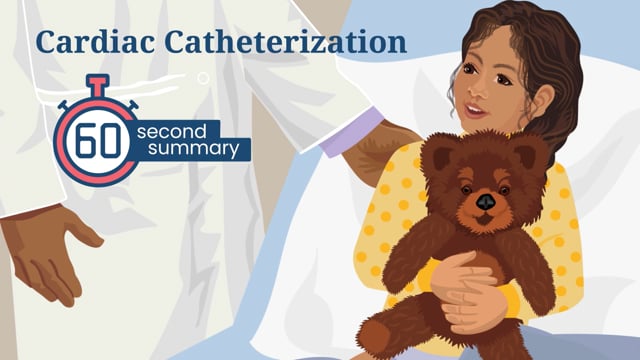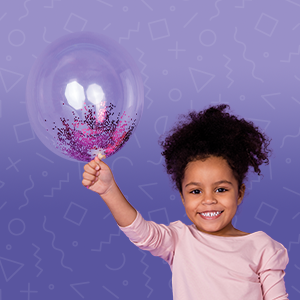Cardiac Catheterization
What Is a Cardiac Catheterization?
A cardiac catheterization is a procedure that cardiologists (heart doctors) do. They put a (a long, thin tube) into a blood vessel, then guide it the heart.
Cardiac catheterizations help doctors diagnose and treat many different heart problems.
Why Are Cardiac Catheterizations Done?
Doctors might do a cardiac catheterization (kath-eh-tur-ih-ZAY-shen) on kids or teens to:
- Look at how the heart and blood vessels are formed and connected.
- Check the pressure and oxygen level in the heart and blood vessels.
- Treat a congenital heart defect (a heart problem that a baby is born with).
- Treat an irregular heartbeat (arrhythmia).
- Open up narrowed blood vessels (called ).
- Repair leaky or narrow heart valves.
-

60-Second Summary: Cardiac Catheterization
Learn the basics in 60 seconds.
How Should We Prepare for a Cardiac Catheterization?
If your child needs a cardiac catheterization, the cardiologist will:
- Give you instructions about when your child should stop eating and drinking. This usually is 6–8 hours before the procedure for food and 4 hours for clear liquids such as water, apple juice, and broth.
- Tell you which medicines your child should continue taking.
- Discuss the risks and benefits of the procedure.
If your child is old enough to understand, talk about what will happen before, during, and after the procedure. Use words your child can understand and let them ask questions.
What Happens During a Cardiac Catheterization?
Doctors do cardiac catheterizations in an operating room called a catheterization lab.
In a cardiac catheterization:
- Your child gets a sedative medicine through an IV line to sleep through the procedure and not feel pain.
- Small sticky patches (electrodes) placed on your child’s chest are attached to an electrocardiograph (ECG) monitor. This checks the heartbeat throughout the procedure.
- The area where the catheter will go in (usually the groin) is shaved (if necessary) and cleaned.
- The cardiologist uses a type of X-ray called fluoroscopy throughout the procedure to see the heart and blood vessels.
- The cardiologist:
- Puts a sheath (a tube about the size of a coffee straw) through the skin and into a blood vessel. The sheath lets the catheter enter the blood vessel smoothly.
- Gently guides a catheter through the sheath, into the blood vessel, and to the heart.
- Checks the pressures and oxygen levels in the heart and blood vessels.
- Puts a type of dye called contrast into the heart to see the heart's vessels, valves, and chambers more clearly.
- Does the test or procedure.
- Removes the catheter and sheath, then bandages the site.
What Happens After Cardiac Catheterization?
You can join your child in the recovery area after the procedure. Your child must lie down and keep the leg that the catheter went in straight until the doctor says it's OK to get up, usually in 4–6 hours.
The doctor will talk to you about:
- whether you should stop the car on the ride home so your child can get up and walk around
- pain medicines
- when your child can eat and drink
- continuing medicines your child was on before the procedure or starting new ones
- when to remove the bandage
- when your child can bathe
- when your child can return regular activities, school, and sports
How Can Parents Help?
Take the bandage off as instructed by the cardiologist, usually the day after the catheterization. Wetting the sticky parts of the bandage will help it come off. Then, dry the area and put a small adhesive bandage over the place where the catheter went in.
Gently wash the area with soap and water at least once a day. Then, cover it with a new adhesive bandage.
For about 2–3 days, your child should take sponge baths or short showers so that the area does not get too wet. They should avoid baths, hot tubs, and swimming, and not use any creams, lotions, or ointments on the area.
Are There Any Risks From Cardiac Catheterization?
Cardiac catheterizations are generally safe procedures. It's normal for the area where the catheter went in to be bruised, sore, or slightly swollen for a couple of days afterward.
More serious problems are uncommon, but can happen. These include:
- bleeding
- allergic reaction to the medicines or contrast dye
- heart attack
- stroke
When Should I Call the Doctor?
Call the cardiologist if your child has:
- bleeding or swelling in the area where the catheter went in
- chest pain
- trouble breathing
- a fever
What Else Should I Know?
Cardiac catheterizations are an important way to diagnose and treat heart problems. Most kids have no problem with the procedure and go home the same day. Sometimes, a child is watched overnight in the hospital. Usually, kids are back to their regular activities within a week.
